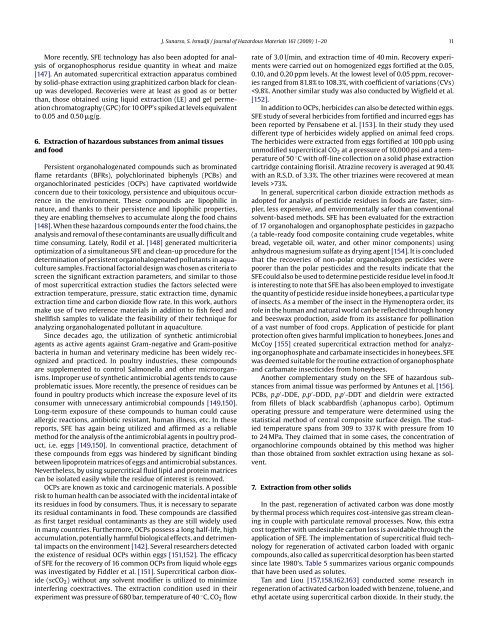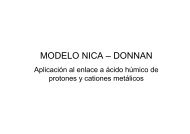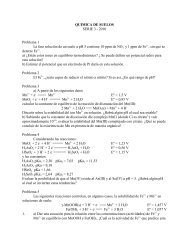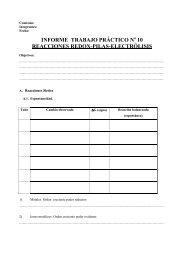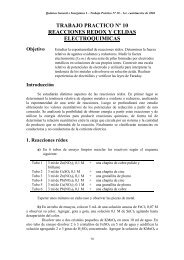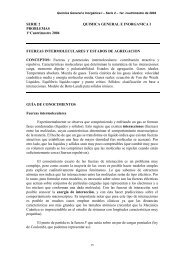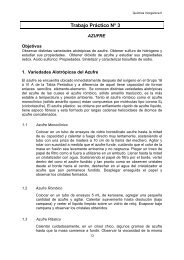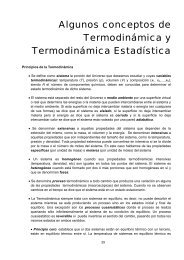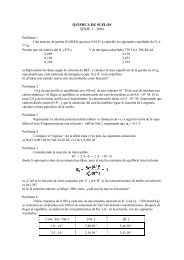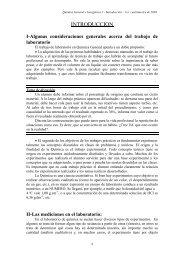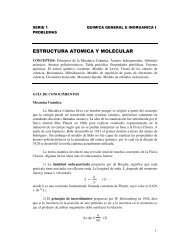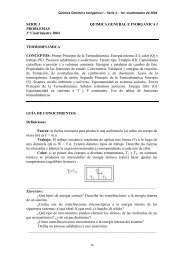Journal of Hazardous Materials Decontamination of hazardous ...
Journal of Hazardous Materials Decontamination of hazardous ...
Journal of Hazardous Materials Decontamination of hazardous ...
Create successful ePaper yourself
Turn your PDF publications into a flip-book with our unique Google optimized e-Paper software.
J. Sunarso, S. Ismadji / <strong>Journal</strong> <strong>of</strong> <strong>Hazardous</strong> <strong>Materials</strong> 161 (2009) 1–20 11More recently, SFE technology has also been adopted for analysis<strong>of</strong> organophosphorus residue quantity in wheat and maize[147]. An automated supercritical extraction apparatus combinedby solid-phase extraction using graphitized carbon black for cleanupwas developed. Recoveries were at least as good as or betterthan, those obtained using liquid extraction (LE) and gel permeationchromatography (GPC) for 10 OPP’s spiked at levels equivalentto 0.05 and 0.50 g/g.6. Extraction <strong>of</strong> <strong>hazardous</strong> substances from animal tissuesand foodPersistent organohalogenated compounds such as brominatedflame retardants (BFRs), polychlorinated biphenyls (PCBs) andorganochlorinated pesticides (OCPs) have captivated worldwideconcern due to their toxicology, persistence and ubiquitous occurrencein the environment. These compounds are lipophilic innature, and thanks to their persistence and lipophilic properties,they are enabling themselves to accumulate along the food chains[148]. When these <strong>hazardous</strong> compounds enter the food chains, theanalysis and removal <strong>of</strong> these contaminants are usually difficult andtime consuming. Lately, Rodil et al. [148] generated multicriteriaoptimization <strong>of</strong> a simultaneous SFE and clean-up procedure for thedetermination <strong>of</strong> persistent organohalogenated pollutants in aquaculturesamples. Fractional factorial design was chosen as criteria toscreen the significant extraction parameters, and similar to those<strong>of</strong> most supercritical extraction studies the factors selected wereextraction temperature, pressure, static extraction time, dynamicextraction time and carbon dioxide flow rate. In this work, authorsmake use <strong>of</strong> two reference materials in addition to fish feed andshellfish samples to validate the feasibility <strong>of</strong> their technique foranalyzing organohalogenated pollutant in aquaculture.Since decades ago, the utilization <strong>of</strong> synthetic antimicrobialagents as active agents against Gram-negative and Gram-positivebacteria in human and veterinary medicine has been widely recognizedand practiced. In poultry industries, these compoundsare supplemented to control Salmonella and other microorganisms.Improper use <strong>of</strong> synthetic antimicrobial agents tends to causeproblematic issues. More recently, the presence <strong>of</strong> residues can befound in poultry products which increase the exposure level <strong>of</strong> itsconsumer with unnecessary antimicrobial compounds [149,150].Long-term exposure <strong>of</strong> these compounds to human could causeallergic reactions, antibiotic resistant, human illness, etc. In thesereports, SFE has again being utilized and affirmed as a reliablemethod for the analysis <strong>of</strong> the antimicrobial agents in poultry product,i.e. eggs [149,150]. In conventional practice, detachment <strong>of</strong>these compounds from eggs was hindered by significant bindingbetween lipoprotein matrices <strong>of</strong> eggs and antimicrobial substances.Nevertheless, by using supercritical fluid lipid and protein matricescan be isolated easily while the residue <strong>of</strong> interest is removed.OCPs are known as toxic and carcinogenic materials. A possiblerisk to human health can be associated with the incidental intake <strong>of</strong>its residues in food by consumers. Thus, it is necessary to separateits residual contaminants in food. These compounds are classifiedas first target residual contaminants as they are still widely usedin many countries. Furthermore, OCPs possess a long half-life, highaccumulation, potentially harmful biological effects, and detrimentalimpacts on the environment [142]. Several researchers detectedthe existence <strong>of</strong> residual OCPs within eggs [151,152]. The efficacy<strong>of</strong> SFE for the recovery <strong>of</strong> 16 common OCPs from liquid whole eggswas investigated by Fiddler et al. [151]. Supercritical carbon dioxide(scCO 2 ) without any solvent modifier is utilized to minimizeinterfering coextractives. The extraction condition used in theirexperiment was pressure <strong>of</strong> 680 bar, temperature <strong>of</strong> 40 ◦ C, CO 2 flowrate <strong>of</strong> 3.0 l/min, and extraction time <strong>of</strong> 40 min. Recovery experimentswere carried out on homogenized eggs fortified at the 0.05,0.10, and 0.20 ppm levels. At the lowest level <strong>of</strong> 0.05 ppm, recoveriesranged from 81.8% to 108.3%, with coefficient <strong>of</strong> variations (CVs)73%.In general, supercritical carbon dioxide extraction methods asadopted for analysis <strong>of</strong> pesticide residues in foods are faster, simpler,less expensive, and environmentally safer than conventionalsolvent-based methods. SFE has been evaluated for the extraction<strong>of</strong> 17 organohalogen and organophosphate pesticides in gazpacho(a table-ready food composite containing crude vegetables, whitebread, vegetable oil, water, and other minor components) usinganhydrous magnesium sulfate as drying agent [154]. It is concludedthat the recoveries <strong>of</strong> non-polar organohalogen pesticides werepoorer than the polar pesticides and the results indicate that theSFE could also be used to determine pesticide residue level in food.Itis interesting to note that SFE has also been employed to investigatethe quantity <strong>of</strong> pesticide residue inside honeybees, a particular type<strong>of</strong> insects. As a member <strong>of</strong> the insect in the Hymenoptera order, itsrole in the human and natural world can be reflected through honeyand beeswax production, aside from its assistance for pollination<strong>of</strong> a vast number <strong>of</strong> food crops. Application <strong>of</strong> pesticide for plantprotection <strong>of</strong>ten gives harmful implication to honeybees. Jones andMcCoy [155] created supercritical extraction method for analyzingorganophosphate and carbamate insecticides in honeybees. SFEwas deemed suitable for the routine extraction <strong>of</strong> organophosphateand carbamate insecticides from honeybees.Another complementary study on the SFE <strong>of</strong> <strong>hazardous</strong> substancesfrom animal tissue was performed by Antunes et al. [156].PCBs, p,p ′ -DDE, p,p ′ -DDD, p,p ′ -DDT and dieldrin were extractedfrom fillets <strong>of</strong> black scabbardfish (aphanopus carbo). Optimumoperating pressure and temperature were determined using thestatistical method <strong>of</strong> central composite surface design. The studiedtemperature spans from 309 to 337 K with pressure from 10to 24 MPa. They claimed that in some cases, the concentration <strong>of</strong>organochlorine compounds obtained by this method was higherthan those obtained from soxhlet extraction using hexane as solvent.7. Extraction from other solidsIn the past, regeneration <strong>of</strong> activated carbon was done mostlyby thermal process which requires cost-intensive gas stream cleaningin couple with particulate removal processes. Now, this extracost together with undesirable carbon loss is avoidable through theapplication <strong>of</strong> SFE. The implementation <strong>of</strong> supercritical fluid technologyfor regeneration <strong>of</strong> activated carbon loaded with organiccompounds, also called as supercritical desorption has been startedsince late 1980’s. Table 5 summarizes various organic compoundsthat have been used as solutes.Tan and Liou [157,158,162,163] conducted some research inregeneration <strong>of</strong> activated carbon loaded with benzene, toluene, andethyl acetate using supercritical carbon dioxide. In their study, the


